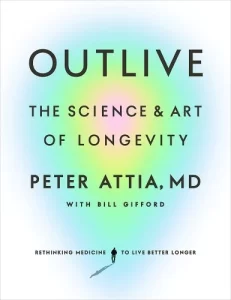Book Review: My Reaction to Peter Attia MD’s new book, “Outlive”
I started listening to Peter Attia MD’s  “The Drive” podcast in December of 2021. At first I was skeptical of some of Dr Attia’s thoughts and positions. I assumed he was a standard medicine 2.0 doctor. Medicine 2.0 is the term that Peter, himself, uses for the current state of health care, or more properly labeled “disease care.” I was quickly convinced that his approaches were much more holistic and thoughtful than typical western medicine.
“The Drive” podcast in December of 2021. At first I was skeptical of some of Dr Attia’s thoughts and positions. I assumed he was a standard medicine 2.0 doctor. Medicine 2.0 is the term that Peter, himself, uses for the current state of health care, or more properly labeled “disease care.” I was quickly convinced that his approaches were much more holistic and thoughtful than typical western medicine.
I started listening to the very first episodes and worked my way through many topics. Peter actually started his podcast as a way to engage experts in different fields to help him create content for his upcoming book. I listened to many of the podcasts several times to fully understand the ideas. Twenty years earlier, in my forties, I quit my job, studied and applied to medical school but did not go. The background in biology and organic chemistry was helpful because many of Peter’s guests are researchers and they tended to go deep into topics.
I adopted much of what I learned from the podcasts. I purchased a sleep tracker and improved my sleep considerably. I also purchased a continuous glucose monitor and wore it for 30 days and changed the way I looked at and consumed food. I started playing the long game as it applies to aging.
Several times in the podcasts Peter mentioned that he was working on a book. When the book was released Peter and his co-author, Bill Gifford recorded a podcast where they discussed the back story of the book. Peter said that his initial manuscript was considered to be too long, too technical and did not reflect his personal experiences. It was suggested that he work with a co-author and that is when he engaged Bill. Peter said that not much of his initial work survived to the published book. Peter also mentioned that his first publisher fired him. He did not say why he was fired, but it seems clear that the book was taking too long and was still reading like a medical school text. The manuscript lay dormant for almost a year until someone asked if they could read it. This person connected Peter with a new publisher and this time they were able to get the book completed..
Since I had listened to over 100 podcasts, I decided to listen to the audio book. The audio recording, read by Peter, is long, over 17 hours long. I finished listening to it last weekend as I was hiking in the grand canyon. The book is also expensive. (Depending on format, price ranges from $13.99 for Kindle to $25.75 for paperback.). Not many first time authors can command a premium price for their book. The audio book cost is $24.50.
Peter starts the book with an overview of aging and how he got into medicine. He discusses the history of medicine. He labels medicine 1.0 as the initial understanding of “germs” and how the light microscope changed how doctors understood cellular function. He discusses the slow transition to medicine 2.0, driven by randomized control trials, where most medicine is practiced today. He describes medicine 2.0 as primarily reactionary and typically dealing with disease when or right before it occurs. Medicine 2.0 frustrated Peter and he quit his residency and became a McKinsey consultant for a few years. Medicine 3.0 he describes as predictive and preventative of disease providing a longer and higher quality of life. This is a reference to the book title “Outlive.”
Peter provides considerable information related to the four main causes of death he calls “the four horseman”. The horsemen are cardiovascular disease, cancer, cerebral vascular disease (such as Alzheimer’s) and metabolic disease. As the length of the recording implies, his coverage of these topics is very thorough and the content was fact checked by experts in each field. The book is not quite as technical as Peter’s podcasts but there is much information presented and I suspect the average consumer does not care to know this much about the nature of these diseases.
Including Bill Gifford as a co-author was a good idea. There are places in the book where Bill’s influence is clear. One type of influence is where a simple metaphor is used to explain a complex topic.
In the next sections Peter focuses on what his experience and the scientific literature has to say about exercise, diet and sleep. He loves to exercise and talk about exercise, but would rather discuss almost anything but diet. Peter’s approach to all three of these topics has changed over the years and I found that history interesting.
Peter was a boxer growing up and was a long distance swimmer and a competitive cyclist. His current approach on exercise focuses on long term health rather than athletic performance. He has set goals for when he turns 100 and uses considerable amounts of both cardiovascular and resistance exercise to support his goals.
His approach to diet is quite simple. Peter suggests that managing glucose and protein intake are key. He avoids at all cost discussing particular diets and the dogmatic approaches that come with them, though he does discuss the challenges of plant based protein. Peter used to fast regularly. In hindsight he does not feel that was the best approach. He laments how much muscle mass he lost due to chronic fasting by comparing his prior and current DEXA scans.
The very shortened version of Peter’s story related to sleep is that we should all be sleeping about seven to eight hours every night and the consequences of short sleep, as he puts it, are severe. For me, I have found I need to be in bed about seven hours and forty five minutes to get seven hours of actual sleep as measured on my tracking device.
I found the most interesting chapter of the book to be Peter’s discussion of emotional health. Peter suggests that emotional health is the most important aspect of aging, because as one of his therapists said, if you are not happy, why would you want to live a long time?
Peter is quite candid and admits here he is the patient and not the physician. This is the one section of the book that I listened to twice. I wanted my girlfriend to hear this chapter with me. She has heard me talk on and on about Peter Attia and she has listened to parts of a couple of podcasts. Peter had challenges as a child and this translated into anger issues as an adult. He shares he very reluctantly went to counseling centers for multiple weeks on two separate occasions. Hearing Peter candidly share his story brought tears to both of our eyes and in my case I had already heard the story once before.
Anyone who is willing to take the time to read or listen to “Outlive” will benefit handsomely from their investment. Because of my prior podcast consumption, my exercise, diet and sleep already aligned with Peter’s strategies and tactics. I had also set goals for when I turn 80 including summiting Kilimanjaro. My personal takeaways from the book were setting higher metabolic goals. I aim to lower my blood glucose A1c from 5.4% to 5.1%. I want to lower my ApoB cholesterol carrying particles to below 50 mg/dl and I want a VO2 max of 50 mL/kg/min which would put me in the top 2% of men 10 years younger than me. 15 years ago I had a VO2 max of 56 mL/kg/min. I also acknowledge that my emotional health would benefit from counseling.
The other big takeaway for me was that I realized that what I really wanted to be when I applied to medical school twenty years ago was to become a medicine 3.0 doctor. I did not want to be a disease management specialist. I wanted to help people prevent disease through a combination of lifestyle and preventative measures such as colonoscopies.
 I am a 60 year old author, motivational speaker, health and fitness disruptor and a coach. My book, “Abs At 60 The Four Steps to Look and Feel Younger at Any Age” was recently released on Amazon. My mission is to assist men over 50 overcome perceived limits of their age to look and feel younger. I do this by applying my four step DOLRTM system that is described in the book. Each chapter has a set of questions for you to answer. You can download a free workbook that includes all of these questions at www.absat60.com.
I am a 60 year old author, motivational speaker, health and fitness disruptor and a coach. My book, “Abs At 60 The Four Steps to Look and Feel Younger at Any Age” was recently released on Amazon. My mission is to assist men over 50 overcome perceived limits of their age to look and feel younger. I do this by applying my four step DOLRTM system that is described in the book. Each chapter has a set of questions for you to answer. You can download a free workbook that includes all of these questions at www.absat60.com.
Greg
Inspiring everyone to live their best life.
720-870-1431
AbsAt60.com


